As of next week, I’ll have been blogging for 20 years, or about 54% of my life. How did that happen?
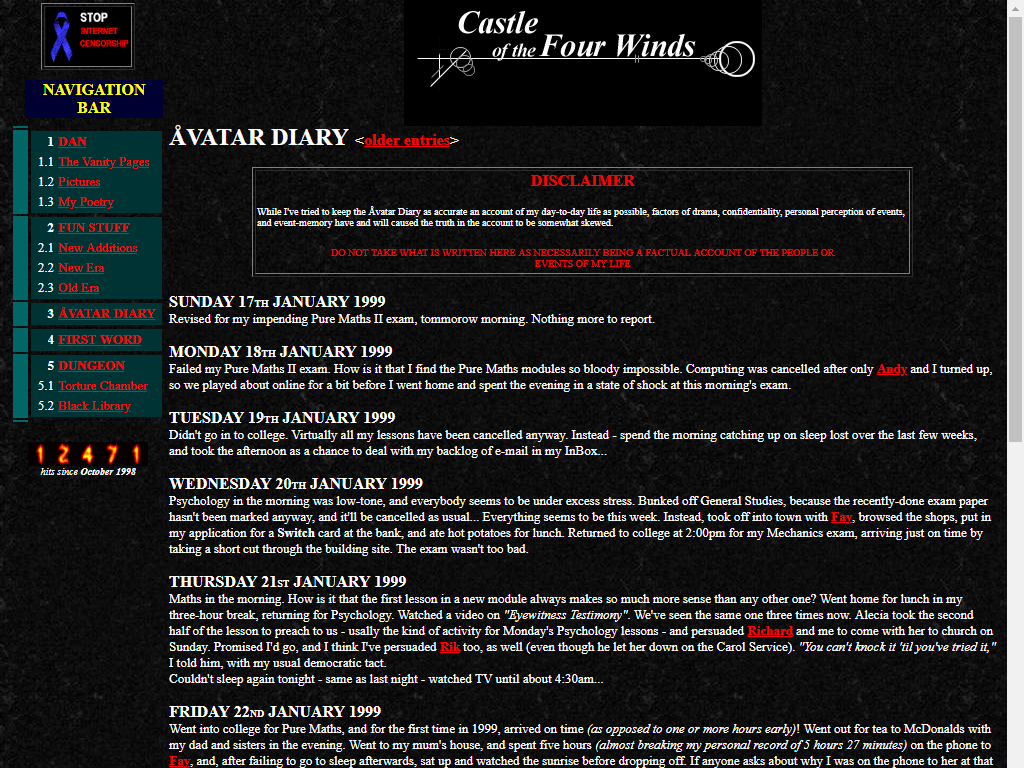
The mid-1990s were a very different time for the World Wide Web (yes, we still called it that, and sometimes we even described its use as “surfing”). Going “on the Internet” was a calculated and deliberate action requiring tying up your phone line, minutes of “connecting” along with all of the associated screeching sounds if you hadn’t turned off your modem’s loudspeaker, and you’d typically be paying twice for the experience: both a monthly fee to your ISP for the service and a per-minute charge to your phone company for the call.
It was into this environment that in 1994 I published my first web pages: as far as I know, nothing remains of them now. It wasn’t until 1998 that I signed up an account with UserActive (whose website looks almost the same today as it did then) who offered economical subdomain hosting with shell and CGI support and launched “Castle of the Four Winds”, a set of vanity pages that included my first blog.
Except I didn’t call it a “blog”, of course, because it wasn’t until the following year that Peter Merholz invented the word (he also commemorated 20 years of blogging, this year). I didn’t even call it a “weblog”, because that word was still relatively new and I wasn’t hip enough to be around people who said it, yet. It was self-described as an “online diary”, a name which only served to reinforce the notion that I was writing principally for myself. In fact, it wasn’t until mid-1999 that I discovered that it was being more-widely read than just by me and my circle of friends when I attracted a stalker who travelled across the UK to try to “surprise” me by turning up at places she expected to find me, based on what I’d written online… which was exactly as creepy as it sounds.
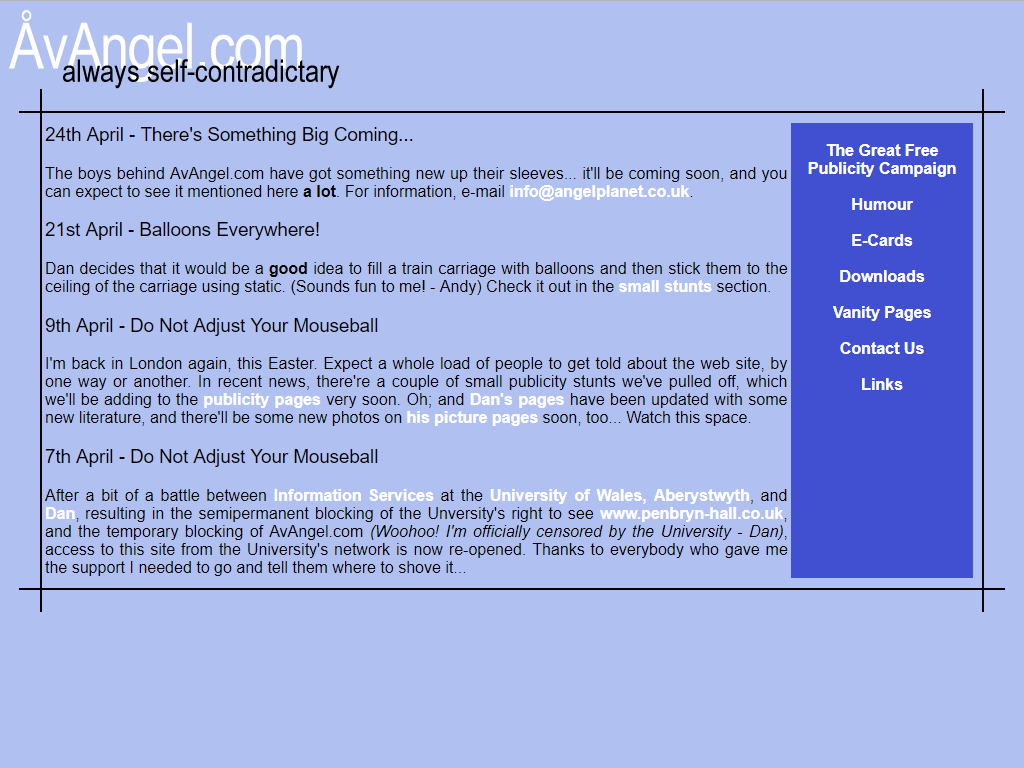
While the world began to panic that the coming millennium was going to break all of the computers, I migrated Castle of the Four Winds’ content into AvAngel.com, a joint vanity site venture with my friend Andy. Aside from its additional content (purity tests, funny stuff, risqué e-cards), what we hosted was mostly the same old stuff, and I continued to write snippets about my life in what was now quite-clearly a “blog-like” format, with the most-recent posts at the top and separate pages for content too old for the front page. Looking back, there’s still a certain naivety to these posts which exemplify the youth of the Web. For example, posts routinely referenced my friends by their email addresses, because spam was yet to become a big enough problem that people didn’t much mind if you put their email address on a public webpage somewhere, and because email addresses still carried with them a feeling of anonymity that ceased to be the case when we started using them for important things.
Technologically-speaking, too, this was a simpler time. Neither Javascript nor CSS support was widespread (nor consistently-standardised) enough to rely upon for anything other than the simplest progressive enhancement unless you were willing to “pick a side” in what we’d subsequently call the first browser war and put one of those apalling “best viewed in Internet Explorer” or “best viewed in Netscape Navigator” banners on your site. I’ve always been a believer in a universal web (and my primary browser at the time was Opera, anyway, as it mostly-remained until Opera went wrong in 2013), and I didn’t have the energy to write everything twice, so our cool/dynamic functionality came mostly from back-end (e.g. Perl, PHP) technologies.
Meanwhile, during my initial months as a student in Aberystwyth, I wrote a series of emails to friends back home entitled “Cool And Interesting Thing Of The Day To Do At The University Of Wales, Aberystwyth”, and put copies of each onto my student webspace; I’ve since recovered these and integrated them into my unified blog.
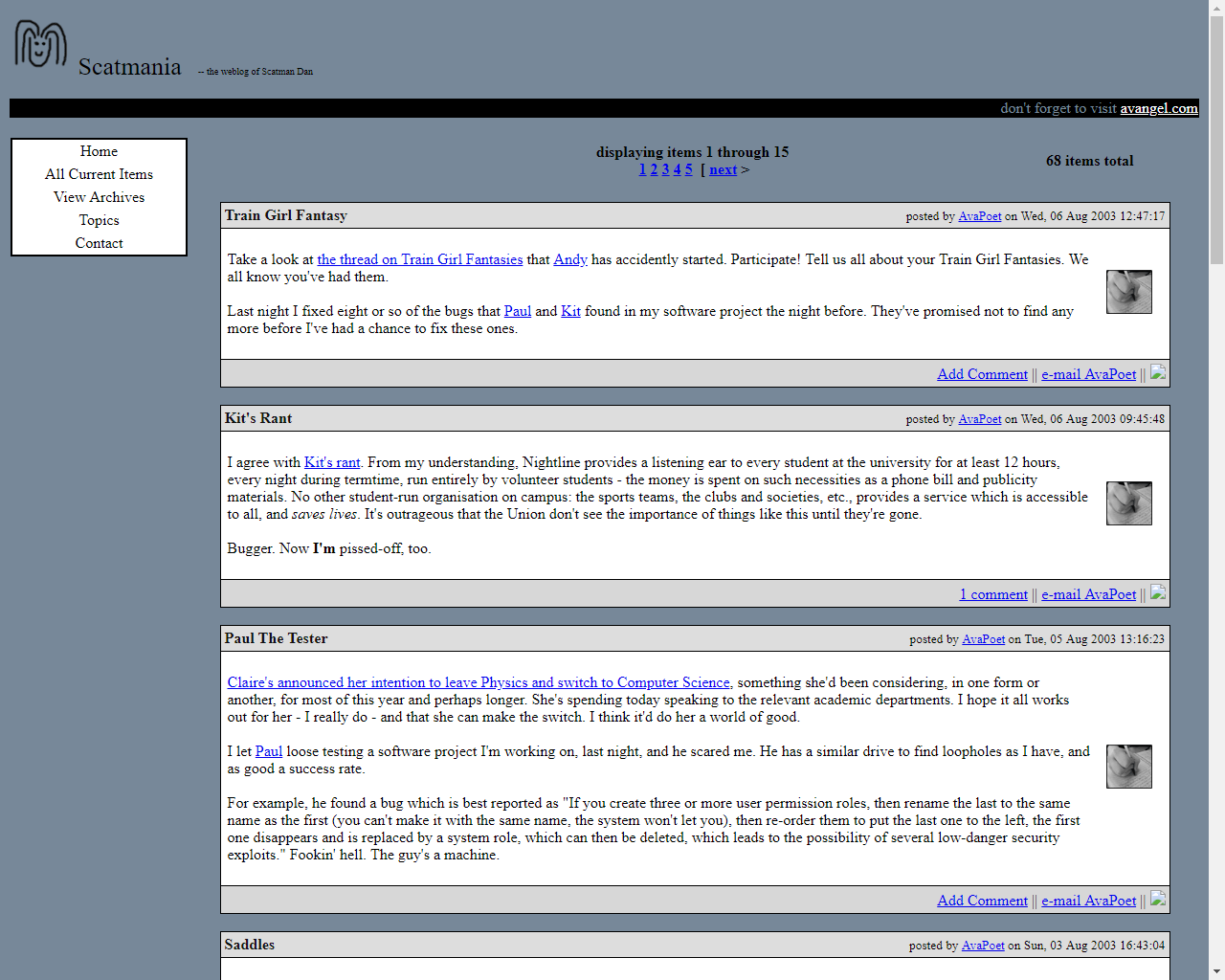
In 2002 I’d bought the domain name scatmania.org – a reference to my university halls of residence nickname “Scatman Dan”; I genuinely didn’t consider the possibility that the name might be considered scatalogical until later on. As I wanted to continue my blogging at an address that felt like it was solely mine (AvAngel.com having been originally shared with a friend, although in practice over time it became associated only with me), this seemed like a good domain upon which to relaunch. And so, in mid-2003 and powered by a short-lived and ill-fated blogging engine called Flip I did exactly that. WordPress, to which I’d subsequently migrate, hadn’t been invented yet and it wasn’t clear whether its predecessor, b2/cafelog, would survive the troubles its author was experiencing.
From this point on, any web address for any post made to my blog still works to this day, despite multiple technological and infrastructural changes to my blog (and some domain name shenanigans!) in the meantime. I’d come to be a big believer in the mantra that cool URIs don’t change: something that as far as possible I’ve committed to trying to upload in my blogging, my archiving, and my paid work since then. I’m moderately confident that all extant links on the web that point to earlier posts are all under my control so they can (and in most cases have) been fixed already, so I’m pretty close to having all my permalink URIs be “cool”, for now. You might hit a short chain of redirects, but you’ll get to where you’re going.
And everything was fine, until one day in 2004 when it wasn’t. The server hosting scatmania.org died in a very bad way, and because my backup strategy was woefully inadequate, I lost a lot of content. I’ve recovered quite a lot of it and put it back in-place, but some is probably gone forever.

The resurrected site was powered by WordPress, and this was the first time that live database queries had been used to power my blog. Occasionally, these days, when talking to younger, cooler developers, I’m tempted to follow the hip trend of reimplementing my blog as a static site, compiling a stack of host-anywhere HTML files based upon whatever-structure-I-like at the “backend”… but then I remember that I basically did that already for six years and I’m far happier with my web presence today. I’ve nothing against static site systems (I’m quite partial to Middleman, myself, although I’m also fond of Hugo) but they’re not right for this site, right now.
IndieAuth hadn’t been invented yet, but I was quite keen on the ideals of OpenID (I still am, really), and so I implemented what was probably the first viable “install-anywhere” implementation of OpenID for WordPress – you can see part of it functioning in the top-right of the screenshot above, where my (copious, at that time) LiveJournal-using friends were encouraged to sign in to my blog using their LiveJournal identity. Nowadays, the majority of the WordPress plugins I use are ones I’ve written myself: my blog is powered by a CMS that’s more “mine” than not!

Over the course of the first decade of my blogging, a few trends had become apparent in my technical choices. For example:
- I’ve always self-hosted my blog, rather than relying on a “blog as a service” or siloed social media platform like WordPress.com, Blogger, or LiveJournal.
- I’ve preferred an approach of storing the “master” copy of my content on my own site and then (sometimes) syndicating it elsewhere: for example, for the benefit of my friends who during their University years maintained a LiveJournal, for many years I had my blog cross-post to a LiveJournal account (and backfeed copies of comments back to my site).
- I’ve favoured web standards that provided maximum interoperability (e.g. RSS with full content) and longevity (serving HTML pages from permanent URLs, adding “extra” functionality via progressive enhancement so as to ensure that content functioned e.g. without Javascript, with CSS disabled or the specification evolved, etc.).
These were deliberate choices, but they didn’t require much consideration: growing up with a Web far less-sophisticated than today’s (e.g. truly stateless prior to the advent of HTTP cookies) and seeing the chaos caused during the first browser war and the period of stagnation that followed, these choices seemed intuitive.
(Perhaps it’s not so much of a coincidence that I’ve found myself working at a library: maybe I’ve secretly been a hobbyist archivist all along!)

As you’d expect from a blog covering a period from somebody’s teen years through to their late thirties, there’ve been significant changes in the kinds of content I’ve posted (and the tone with which I’ve done so) over the years, too. If you dip into 2003, for example, you’ll see the results of quiz memes and unqualified daily minutiae alongside actual considered content. Go back further, to early 1999, and it is (at best) meaningless wittering about the day-to-day life of a teenage student. It took until around 2009/2010 before I actually started focussing on writing content that specifically might be enjoyable for others to read (even where that content was frankly silly) and only far more-recently-still that I’ve committed to the “mostly technical stuff, ocassional bits of ‘life’ stuff” focus that I have today.
I say “committed”, but of course I’m fully aware that whatever this blog is now, it’ll doubtless be something somewhat different if I’m still writing it in another two decades…
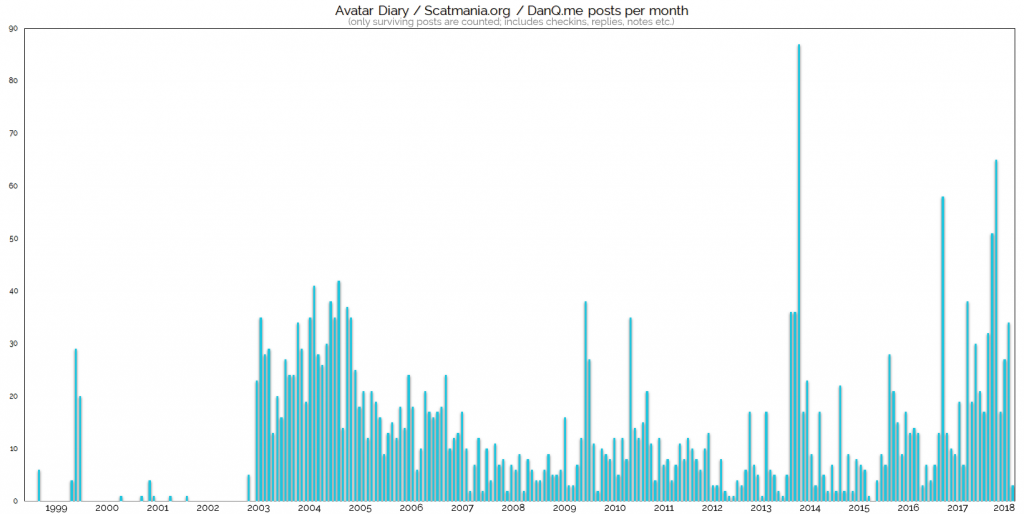
Once I reached the 2010s I started actually taking the time to think about the design of my blog and its meaning. Conceptually, all of my content is data-driven: database tables full of different “kinds” of content and associated metadata, and that’s pretty-much ideal – it provides a strong separation between content and presentation and makes it possible to make significant design changes with less work than might otherwise be expected. I’ve also always generally favoured a separation of concerns in web development and so I’m not a fan of CSS design methodologies that encourage class names describing how things should appear, like Atomic CSS. Even where it results in a performance hit, I’d far rather use CSS classes to describe what things are or represent. The single biggest problem with this approach, to my mind, is that it violates the DRY principle… but that’s something that your CSS preprocessor’s there to fix for you, isn’t it?
But despite this philosophical outlook on the appropriate gap between content and presentation, it took until about 2010 before I actually attached any real significance to the presentation at all! Until this point, I’d considered myself to have been more of a back-end than a front-end engineer, and felt that the most-important thing was to get the content out there via an appropriate medium. After all, a site without content isn’t a site at all, but a site without design is (or at least should be) still intelligible thanks to browser defaults! Remember, again, that I started web development at a time when stylesheets didn’t exist at all.
My previous implementations of my blog design had used simple designs, often adapted from open-source templates, in an effort to get them deployed as quickly as possible and move on to the next task, but now, I felt, it was time to do a little more.
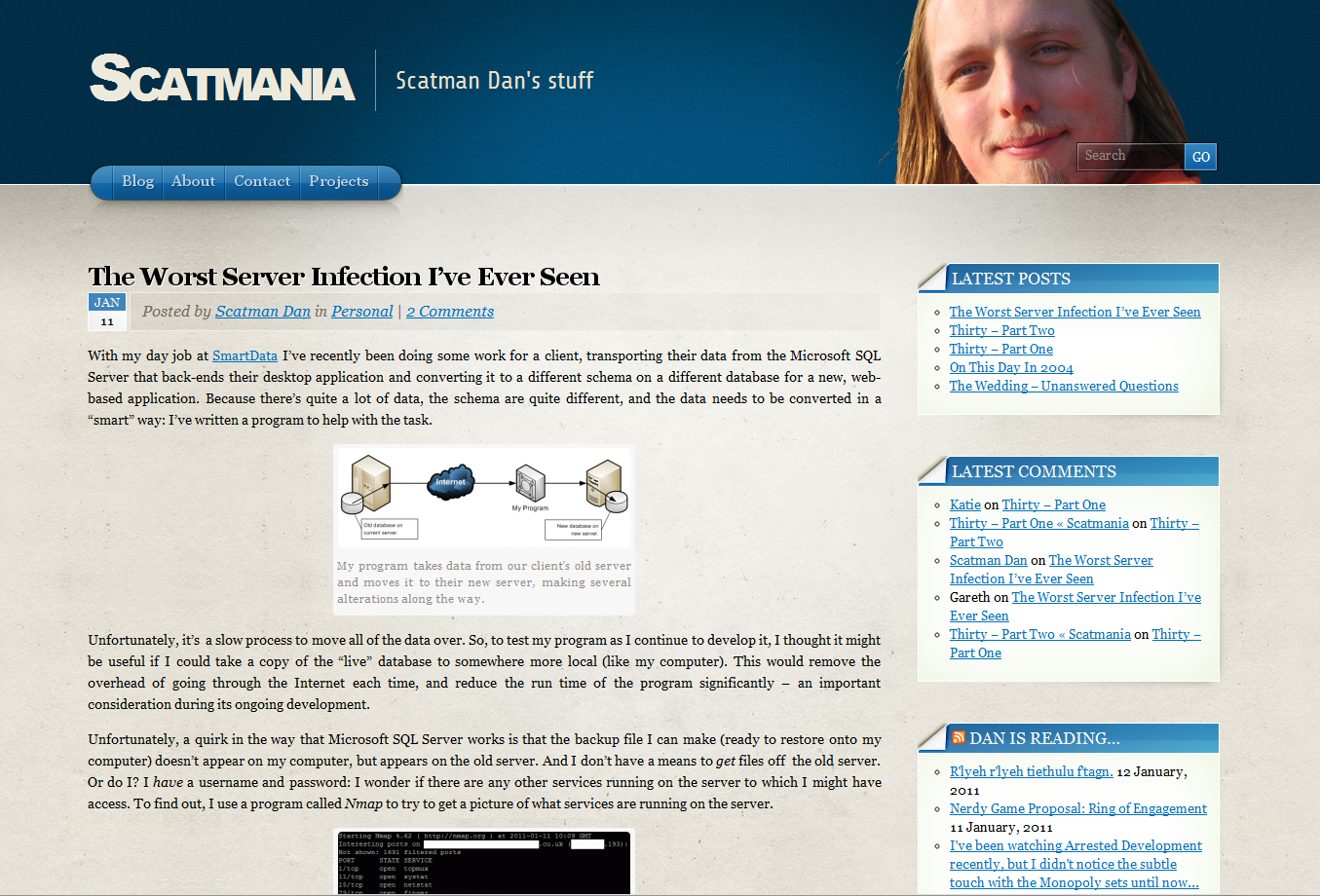
For a few years, I was producing a new theme once per year. I experimented with different colours, fonts, and layouts, and decided (after some ad-hoc A/B testing) that my audience was better-served by a “front” page than by being dropped directly into my blog archives as had previously been the case. Highlighting the latest few – and especially the very-latest – post and other recent content increased the number of posts that a visitor would be likely to engage with in a single visit. I’ve always presumed that the reason for this is that regular (but non-subscribing) readers are more-likely to be able to work out what they have and haven’t read already from summary text than from trying to decipher an entire post: possibly because my blogging had (has!) become rather verbose.
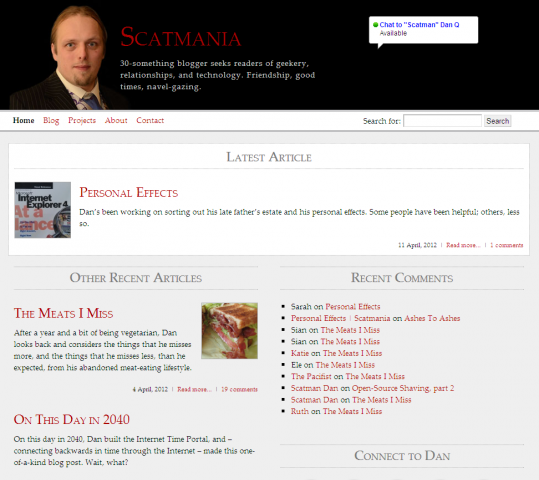
I went through a bit of a lull in blogging: I’ve joked that I spent more time on my 2010 and 2011 designs than I did on the sum total of the content that was published in between the pair of them (which isn’t true… at least, not quite!). In the month I left Aberystwyth for Oxford, for example, I was doing all kinds of exciting and new things… and yet I only wrote a total of two blog posts.
With RSS waning in popularity – which I can’t understand: RSS is amazing! – I began to crosspost to social networks like Twitter and Google+ (although no longer to Google+, following the news of its imminent demise) to help those readers who prefer to get their content via these media, but because I wasn’t producing much content, it probably didn’t make a significant difference anyway: the chance of a regular reader “missing” something must have been remarkably slim.
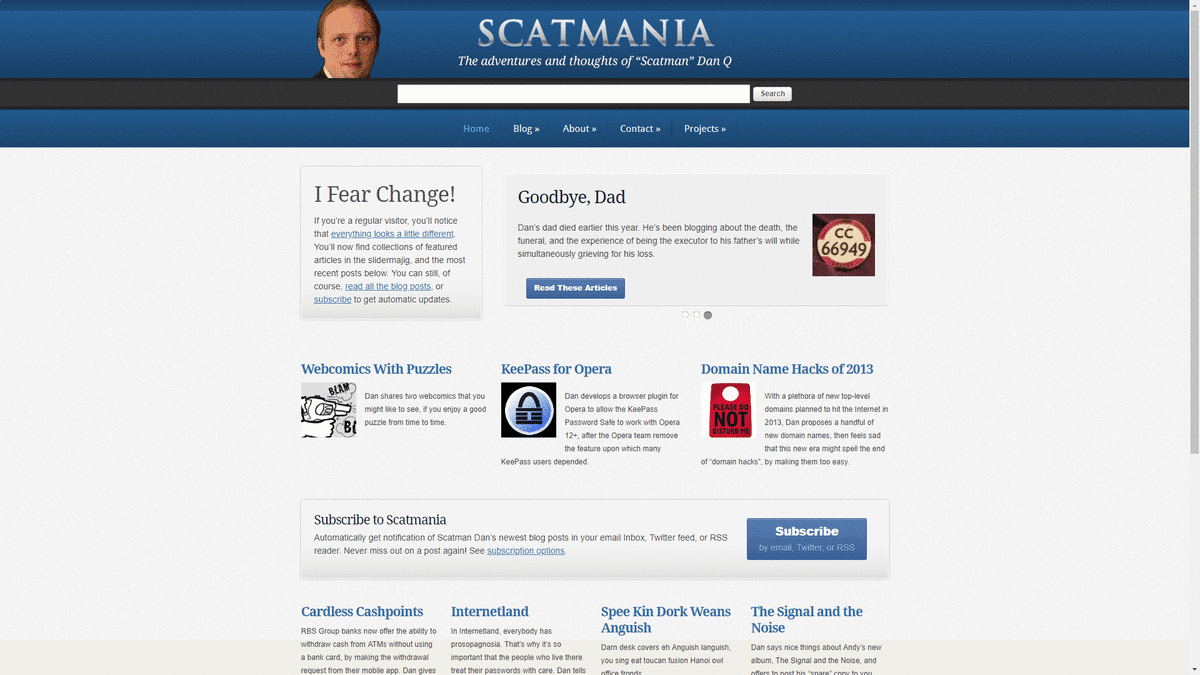
Nobody calls me “Scatman Dan” any more, and hadn’t for a long, long time. Given that my name is already awesome and unique all by itself (having changed to be so during the era in which scatmania.org was my primary personal domain name), it felt like I had the opportunity to rebrand.
I moved my blog to a new domain, DanQ.me (which is nice and short, too) and came up with a new collection of colours, fonts, and layout choices that I felt better-reflected my identity… and the fact that my blog was becoming less a place to record the mundane details of my daily life and more a place where I talk about (principally-web) technology, security, and GPS games… and just occasionally about other topics like breadmaking and books. Also, it gave me a chance to get on top of the current trend in web design for big, clean, empty spaces, square corners, and using pictures as the hook to a story.
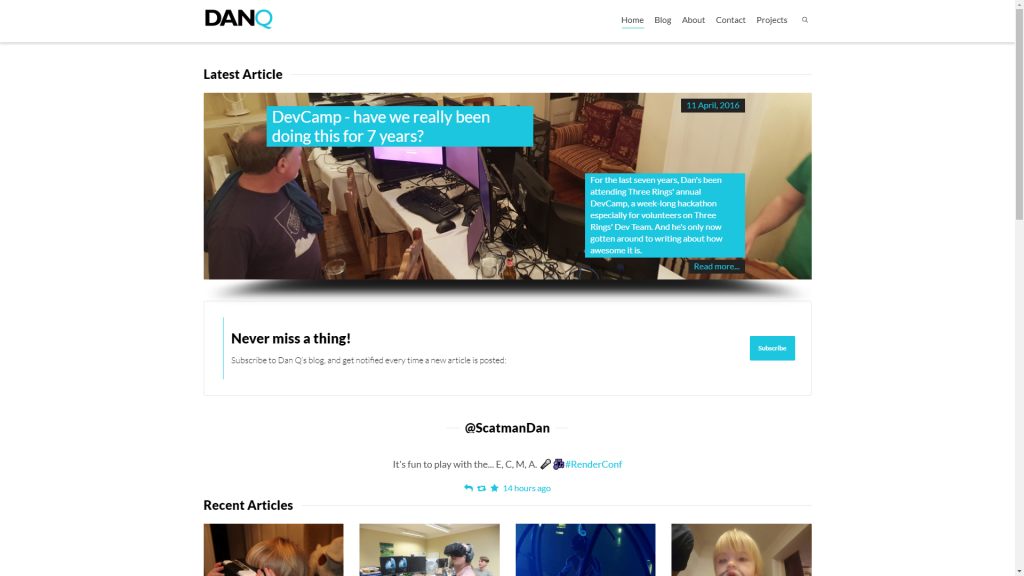
I’ve been working harder this last year or two to re-integrate (in a PESOS-like way) into my blog content that I’ve published elsewhere, mostly geocaching logs and geohashing expedition records, and I’ve also done so retroactively, so in addition to my first blog article on the subject of geocaching, you can read my first ever cache log without switching to a different site nor relying upon the continued existence and accessibility of that site. I’ve been working at being increasingly mindful of where my content is siloed outside of my control and reclaiming it by hosting it here, on my blog.
Particular areas in which I produce content elsewhere but would like to at-least maintain a copy here, and would ideally publish here first and syndicate elsewhere, although I appreciate that this is difficult, are:
- GPS games like geocaching and geohashing – I’ve mostly got this under control, but could enjoy streamlining the process or pushing towards POSSE
- Reddit, where I’ve written tens of thousands of words under a variety of accounts, but I don’t really pay attention to the site any more
- I left Facebook in 2011 but I still have a backup of what was on my “Wall” at that point, which I could look into reintegrating into my blog
- I share a lot of the source code I write via my GitHub account, but I’m painfully aware that this is yet-another-silo that I ought to learn not to depend upon (and it ought to be simple enough to mirror my repos on my own site!)
- I’ve got a reasonable number of videos on two YouTube channels which are online by Google’s good graces (and potential for advertising revenue); for a handful of technical reasons they’re a bit of a pain to self-host, but perhaps my blog could act as a secondary source to my own video content
- I write business reviews on Google Maps which I should probably look into recovering from the hivemind and hosting here… in fact, I’ve probably written plenty of reviews on other sites, too, like Amazon for example…
- On two previous occasions I’ve maintained an online photo gallery; I might someday resurrect the concept, at least for the photos that used to be published on them
- I’ve dabbled on a handful of other, often weirder, social networks before like Scuttlebutt (which has a genius concept, by the way) and Ello, and ought to check if there’s anything “original” on there I should reintegrate
- Going way, way back, there are a good number of usenet postings I’ve made over the last twenty-something years that I could reclaim, if I can find them…
(if you’re asking why I’m inclined to do all of these things: here’s why)
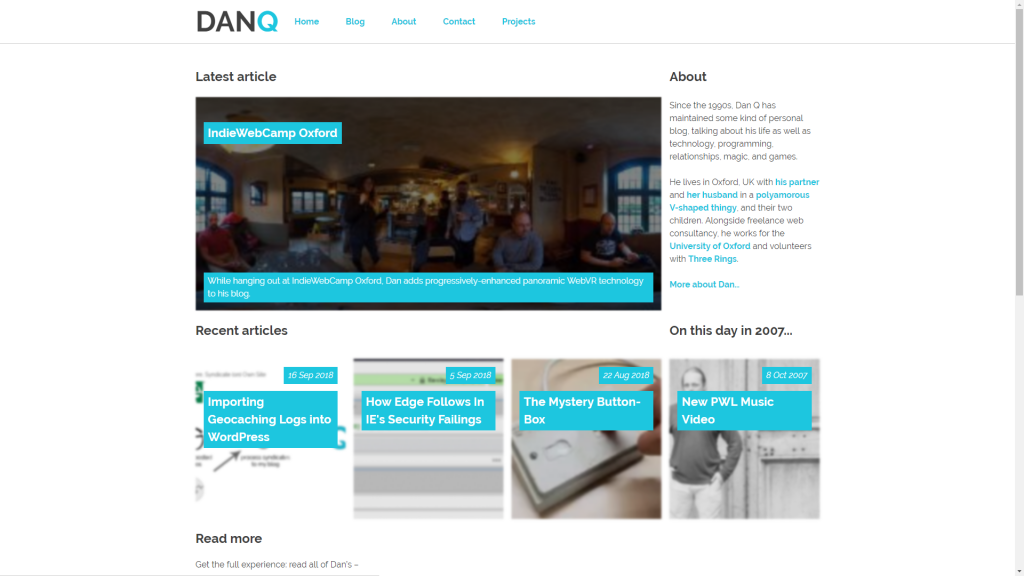
20 years and around 717,000 words worth of blogging down, it’s interesting to look back and see how things have changed: in my life, on the Web, and in the world in general. I’ve seen many friends’ blogs come and go: they move into a new phase of their life and don’t feel like what they wrote before reflects them today, most often, and so they delete them… which is fine, of course: it’s their content! But for me it’s always felt wrong to do so, for two reasons: firstly, it feels false to do so given that once something’s been put on the Web, it might well be online forever – you can’t put the genie back in the bottle! And secondly: for me, it’s valuable to own everything I wrote before. Even the cringeworthy things I wrote as a teenager who thought they knew everything and the antagonistic stuff I wrote in my early 20s but that I clearly wouldn’t stand by today is part of my history, and hiding that would be a disservice to myself.
The 17-year-old who wrote my first blog posts two decades ago this month fully expected that the things he wrote would be online forever, and I don’t intend to take that away from him. I’m sure that when I write a post in October 2038 looking back on the next two decades, I’ll roll my eyes at myself today, too, but for me: that’s part of the joy of a long-running personal blog. It’s like a diary, but with a sense of accountability. It’s a space on the web that’s “mine” into which I can dump pretty-much whatever I like.
I love it: I’ve been blogging for over half of my life, and if I can get back to you in 2031 and tell you that I’ve by-then been doing so for two-thirds of my life, that would be a win.
I liked the peekaboo header, yeah. When I felt down I would go to the page and make you bob up and down. Sometimes I would say “boo!” to myself when you came back up. I regret nothing.